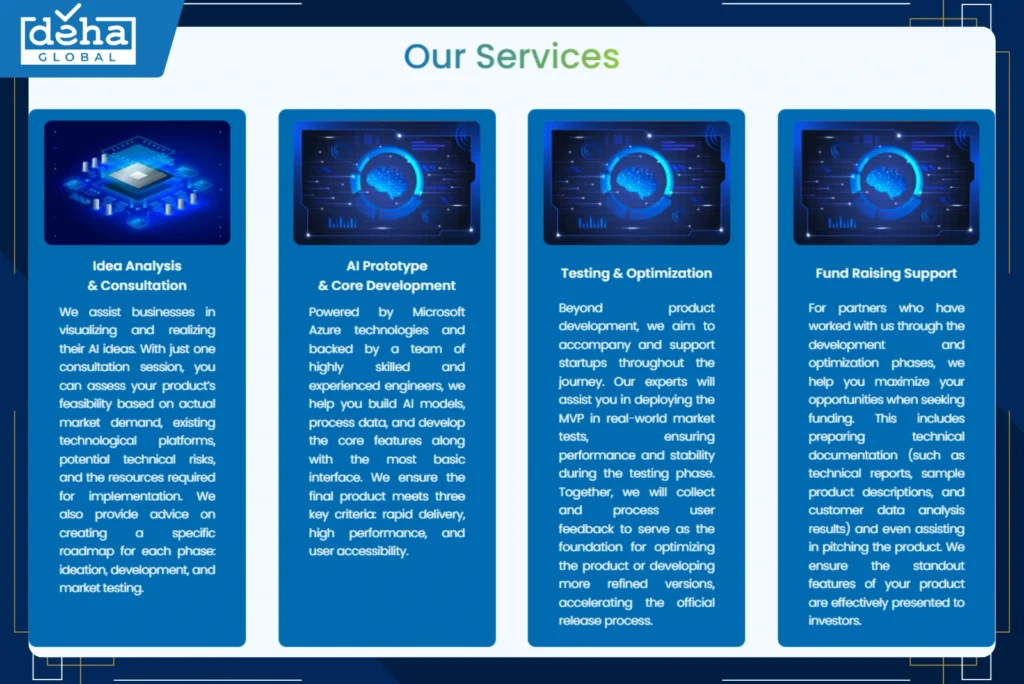Table of contents

In the last few years, many startups have faced the challenge of developing Minimum Viable Products (MVPs) with AI capabilities while operating under tight budgets and limited resources. This can make the journey from concept to launch seem daunting.
To help you navigate this landscape, this article offers practical strategies and showcases real-world examples of startups that have successfully built AI-powered MVPs despite resource constraints. By learning from these insights, your business can effectively leverage AI to create impactful products without overstretching your resources.
Developing an AI-powered Minimum Viable Product (MVP) with limited resources presents several challenges that can significantly impact the project’s success. Below are four primary obstacles:
1. Limited Technical Expertise
Building an AI MVP necessitates specialized knowledge in machine learning, data science, and AI system integration. Startups with limited technical expertise may struggle to design effective AI models, leading to suboptimal performance. This deficiency can result in increased reliance on external consultants, further straining limited budgets.
The absence of in-house AI proficiency hampers the ability to make informed decisions about model selection, data handling, and system architecture. Consequently, the development process may experience delays, and the final product might not meet desired performance benchmarks. This situation underscores the importance of acquiring or developing technical skills within the team to navigate the complexities of AI development effectively.
2. Budget Constraints
Developing AI solutions involves significant costs, including expenses for data acquisition, computational resources, and specialized personnel. Startups operating with limited budgets may find it challenging to allocate sufficient funds to these critical areas. Insufficient investment can lead to compromises in data quality, model sophistication, and overall system robustness.
Financial limitations may force startups to prioritize certain features over others, potentially resulting in a product that lacks essential functionalities. Moreover, cutting corners to save costs can lead to technical debt, requiring additional resources in the future to address shortcomings. Therefore, careful financial planning and resource allocation are crucial to balance cost constraints with the need for a viable AI MVP.

3. Low Data Acquisition and Quality
High-quality, relevant data is the backbone of effective AI systems. Startups with limited resources may struggle to collect sufficient datasets, leading to challenges in training accurate models. Data scarcity or poor-quality data can result in models that perform inadequately, diminishing the product’s value and user trust.
Without access to diverse and comprehensive data, AI models may exhibit biases or fail to generalize across different scenarios. This limitation hampers the MVP’s ability to meet user expectations and business objectives. Addressing this challenge requires innovative data collection strategies and partnerships to enrich datasets without incurring prohibitive costs.
4. Decreased Scalability
Scalability is essential for AI systems to accommodate growth in user base and data volume. Resource constraints can lead to architectures that are not designed for scalability, resulting in performance bottlenecks as demand increases. This limitation can hinder the product’s ability to serve a growing user base effectively.
Lack of scalability can necessitate costly overhauls of the system architecture in the future, diverting resources from other critical areas. Ensuring that the AI MVP is built on scalable infrastructure from the outset is vital to support long-term growth and adaptability. Strategic planning and investment in scalable solutions can prevent these challenges and position the product for success in a competitive market.
Recognizing and proactively addressing these challenges are essential steps for startups aiming to develop successful AI MVPs with limited resources.
I understand that the development of an AI-powered Minimum Viable Product (MVP) on a tight budget or resources is a common challenge for startups. However, with strategic planning and resourcefulness, it’s entirely possible to bring your AI MVP to life without overspending. Here are five practical strategies to help you navigate this process effectively to handle the potential challenges above:
1. Collaborate with Specialized MVP Development Partners
Engaging with MVP development companies that specialize in AI integration can bridge the technical expertise gap. These partners bring a wealth of experience in transforming ideas into viable products, ensuring that technical complexities are adeptly managed. For instance, Program-Ace assists startups by providing necessary specialists and optimizing limited resources, enabling efficient AI MVP development without the overhead of building an in-house team.
Impact:
This collaboration allows startups to leverage external expertise, ensuring that AI components are seamlessly integrated into the MVP. It mitigates the risks associated with technical shortcomings, accelerates development timelines, and enhances the overall quality of the product.
2. Implement Lean Development Practices
Adopting lean development methodologies focuses on delivering core functionalities that address essential user needs, thereby optimizing resource utilization. By concentrating on the MVP’s minimum viable features, startups can allocate budgets more effectively, avoiding unnecessary expenditures. This approach aligns with the principle of building a simplified version of the product that zeroes in on the most critical features, as emphasized by Space-O Technologies.
Impact:
Lean development minimizes wasteful spending, ensures that resources are directed towards features with the highest impact, and facilitates a quicker time-to-market. This strategy enhances the likelihood of securing user feedback and achieving product-market fit without overextending financial resources.
3. Utilize Cost-Effective Data Collection and Enhancement Techniques
Employing cost-effective data collection methods, such as leveraging publicly available datasets, crowdsourcing, or partnering with organizations willing to share data, can enrich the data pool without significant investment. Additionally, focusing on enhancing data quality through cleaning and preprocessing ensures that the AI models are trained on reliable information. Maxiom Tech highlights the importance of focusing on key strategies from planning to feedback integration to build a successful MVP within budget constraints.
Impact:
Improving data quality enhances the accuracy and reliability of AI models, leading to better user experiences. Cost-effective data acquisition prevents budget overruns, allowing funds to be allocated to other critical areas of development.
4. Design with Modular and Scalable Architecture
Implementing a modular architecture allows individual components of the AI system to be scaled independently based on demand. This design approach facilitates efficient resource management and ensures that the system can handle increased loads without compromising performance. Django Stars emphasizes the importance of building a scalable MVP to accommodate future growth and user base expansion.
Impact:
A modular and scalable design ensures that the AI MVP can adapt to growing user demands, maintain optimal performance, and incorporate future enhancements with minimal disruption. This strategy positions the product for long-term success and user satisfaction.

By implementing these strategies, startups can effectively navigate the challenges of developing an AI MVP with limited resources, paving the way for successful product launches and sustainable growth.
Even though launching an AI-driven Minimum Viable Product (MVP) on a tight budget might seem daunting, numerous startups have navigated this challenge successfully. By focusing on essential features and leveraging existing technologies, these companies have transformed their innovative ideas into thriving businesses.
Let’s explore three notable examples that demonstrate how limited resources can still lead to remarkable achievements in AI MVP development.
1. Dropbox: Implement Lean Development Practices
Dropbox addressed resource constraints by adopting lean development practices, focusing on validating their concept before full-scale development. They created a simple explainer video demonstrating the product’s functionality, effectively gauging user interest without investing heavily in development.
Impact:
This approach allowed Dropbox to test market demand and attract early users without significant upfront costs, ensuring that resources were allocated efficiently based on validated interest.
2. Airbnb: Utilize Cost-Effective Data Collection and Enhancement Techniques
Airbnb leveraged cost-effective data collection methods to overcome limited resources. They began by creating a basic website featuring photos of their apartment, aiming to test the demand for short-term rentals without extensive investment.
Impact:
This strategy enabled Airbnb to validate their business idea and gather valuable user feedback without significant financial expenditure, laying the foundation for their platform’s growth.

3. Uber: Design with Modular and Scalable Architecture
Uber focused on designing a modular and scalable architecture to efficiently manage resources. They started with a beta version of UberCab, limiting access to select users, and gradually expanded features based on user feedback and demand.
Impact:
This approach allowed Uber to scale their platform effectively, introducing new features incrementally while managing resource constraints, leading to widespread adoption.

The challenges of integrating advanced AI technologies, managing development costs, and accelerating time-to-market can seem overwhelming. However, partnering with DEHA Global offers a strategic solution to navigate these obstacles effectively.

DEHA Global specializes in transforming innovative ideas into market-ready AI MVPs, even within constrained budgets. Their comprehensive suite of services is tailored to meet the unique needs of startups and resource-conscious enterprises:
By choosing DEHA Global, startups and businesses with limited resources can effectively navigate the complexities of AI MVP development. Their expertise, competitive pricing, and comprehensive support empower you to bring your AI-driven product to market efficiently and successfully
Building an AI MVP with limited resources is undoubtedly challenging, but with the right approach, it’s entirely achievable. By focusing on core functionalities, utilizing existing AI services, and adopting agile development practices, you can efficiently bring their AI-driven products to market.
Remember, the goal is to validate your idea and gather user feedback without exhausting your resources. With careful planning and strategic execution, your business can harness the power of AI to drive innovation and success.